Most types of furry caterpillars are native to North America and the United Kingdom. They love munching on the leaves of trees, shrubs, and crops in the garden. Some species are considered garden pests due to their destructive traits.
Identifying the exact name of these crawling creatures can be a daunting experience for many gardeners. This hairy caterpillar identification guide highlights the descriptions and pictures for easy identification.
Are Furry Caterpillars Poisonous?
Hairy caterpillars are non-poisonous despite the hair tufts covering their bodies. But there are some species that have venomous-filled spines.
Refrain from handling or picking these furry caterpillars to avoid severe skin irritation and itchy rashes. The toxic substances in the caterpillars can be poisonous to birds.
Some furry caterpillars have hidden sharp spines or setae that can give you a severe sting or bite when handled. Be sure to wear protective gloves when handling them.
Different Types of Furry Caterpillars
Identification of furry or hairy caterpillars can be a daunting experience for novices and some experts. Here is a list of 20 different types of furry caterpillars with their names, description, and pictures:
Banded Woolly Bear Caterpillar
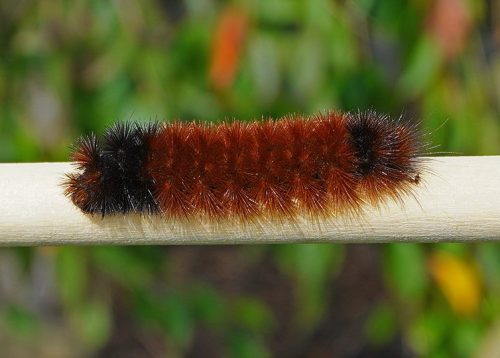
It is a hairy black and orange caterpillar with six legs, a small black head, and 13 segments for easy identification. The broad orange band around the center and black ends are the distinctive features.
The fluffy appearance makes these banded woolly bear caterpillars deceptive from their stinging counterparts. The spiny hairs can cause skin irritation and itchy rashes upon handling them.
These caterpillars feed on clovers, dandelions, violets, nettles, and yellow docks. These hairy caterpillars turn into orange Isabella tiger moths after pupation. The caterpillar grows up to 50mm long.
Scientific Name |
Pyrrharctia isabella |
Host Plants |
Dandelions, violets, nettles, and clovers |
Identification Features |
Hairy black and orange caterpillar that rolls when feels threatened. |
Sycamore Tussock Caterpillar
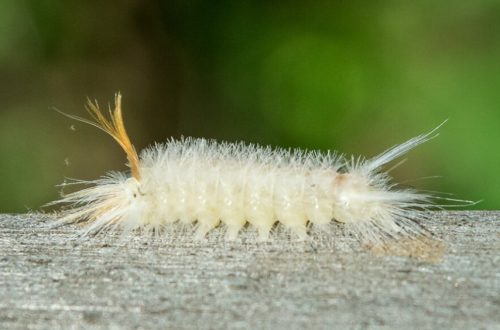
It is a unique white furry caterpillar with a pair of hair pencils from both ends. The sycamore tussock caterpillar has an orange head and white bristly hair covering its body.
The spiny tufts cause skin irritation and inflammation though the caterpillar does not sting or bite. These larvae love feeding on the leaves of American Sycamore trees before turning into moths.
Scientific Name |
Halysidota harrisii |
Host Plants |
American sycamore trees |
Identification Features |
Hairy white body with two long orange pencil hairs from both ends. |
Banded Tussock Moth Caterpillar
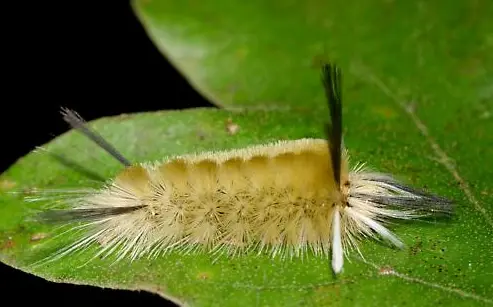
It is a hairy grayish moth caterpillar with distinctive long black hair tufts protruding from its end. Other distinctive features are the black stripe along its back and a bright orange head covered in hair tufts.
These moth caterpillars love munching the leaves of birch, ash, alder, oak, and willow trees. But these larvae do not damage the trees or shrubs in your garden despite chewing their leaves.
Scientific Name |
Halysidota tessellaris |
Host Plants |
Birch, ash, alder, oak, and willow trees |
Identification Features |
Six tufts of long black lashes and two shorter white hair tufts. |
American Dagger Caterpillar
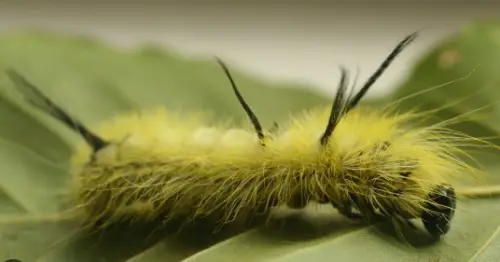
It is a furry yellow caterpillar with long wispy pale yellow hairs around its body. The rounded shiny black head and two pairs of long black hairs on its back are the distinctive features.
The caterpillar is non-venomous though the hair tufts can cause skin irritation and nasty rashes upon handling or touching. The irritation occurs when the bristly yellow hairs break into the skin.
These larvae feed on the leaves of the birch, oak, elm, and maple trees. They are often seen between the month of July and October. These caterpillars turn into American dagger moths after pupation.
Scientific Name |
Acronicta americana |
Host Plants |
Maple, elm, birch, and oak |
Identification Features |
Shaggy pale-yellow body with two pairs of long black hairs on its back. |
Sycamore Moth Caterpillar
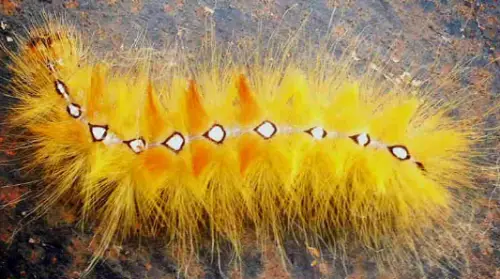
It is a colorful moth caterpillar with a fluffy appearance and unusual markings for easy identification. The white diamond lines along the back bordered by black are the distinctive features.
The red and yellow hair tufts alternate along its body. These moth larvae are often seen in late summer and autumn when they drop from the trees. These hair tufts can cause skin irritation upon touching or handling.
Sycamore moth caterpillars are native to the southern half of England. They are scarce in North and South East England. They are prominent in parks, gardens, and woodland since they feed on the leaves of maple, horse chestnuts, and other deciduous trees.
Scientific Name |
Acronicta aceris |
Host Plants |
Maple and horse chestnut trees |
Identification Features |
Orangey-yellow hair tufts in a pyramid shape and rows of white dots along its back. |
Milkweed Tiger Moth Caterpillar
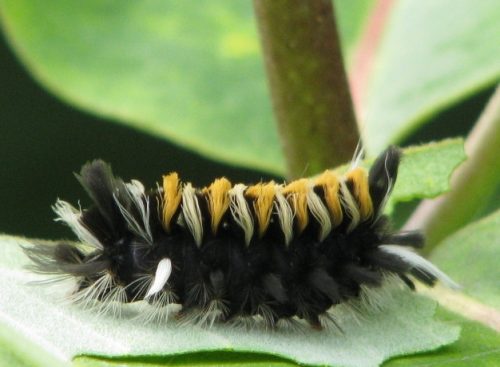
It is a hairy worm-like caterpillar with black, white, and orange furry tufts around its body. The orangey appearance is more prominent when the caterpillar is about to undergo pupation.
The hairy caterpillar feeds on milkweeds and dogbane plants. They extract toxic substances from these plants to become poisonous to birds and predators. These caterpillars grow up to 35mm long.
Scientific Name |
Euchaetes egle |
Host Plants |
Milkweed and dogbane plants. |
Identification Features |
Black, orange, and white tufts cover the body. |
White-Marked Tussock Caterpillar
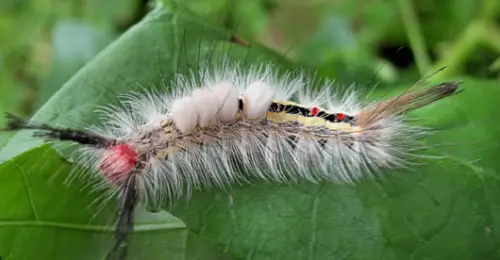
The hairy Florida caterpillar has black and yellow tufts covering its body. The four white toothbrush tufts on its back and numerous red dots are the distinctive features for easy identification.
The furry caterpillar also has long pencil hairs on both ends and conspicuous yellow stripes on its black body. The spiky tufts can cause a stinging sensation upon handling or touching with protective gear.
Scientific Name |
Orgyia leucostigma |
Host Plants |
Apple, birch, black locust, cherry, elm, fir, hackberry, and hickory. |
Identification Features |
Four bushy white tufts on its back, yellow stripes, and wispy white and black spines. |
Southern Flannel Moth Caterpillar
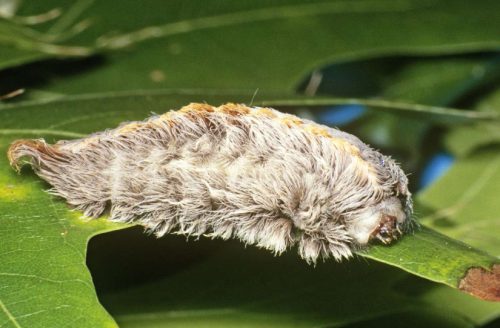
It is a hairy brown caterpillar with a deceptive soft appearance. But the furry covering of the body hides venomous spines that cause nasty rashes and skin irritation when handled without protective gloves.
The stinging caterpillar grows up to 25mm long and its body color ranges from dark gray to golden brown. other common names for this moth caterpillar are Italian asp, fire caterpillar, woolly slug, and puss moth.
Scientific Name |
Megalopyge opercularis |
Host Plants |
|
Identification Features |
Disheveled golden brown hairs |
Yellow Woolly Bear Caterpillar
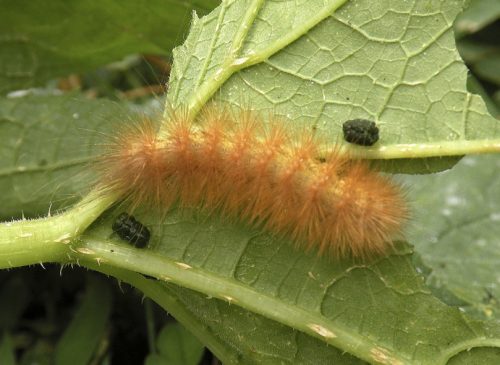
It is a slug-like insect caterpillar with bronze-brown hair tufts covering its body. The crawling insect also has a soft fuzzy appearance that can attract potential predators or for easy identification.
The yellowish-brown or golden-brown woolly bear keeps changing its colors depending on the habitat. Some can be black, orangey-red, and dark yellow with hairy tufts that cause localized skin irritation.
Scientific Name |
Spilosoma virginica |
Host Plants |
Asparagus, beans, beet, cabbage, carrot, cauliflower, and celery. |
Identification Features |
Yellow or orange-brown hair tufts covering the brownish-tan body |
Garden Tiger Moth Caterpillar
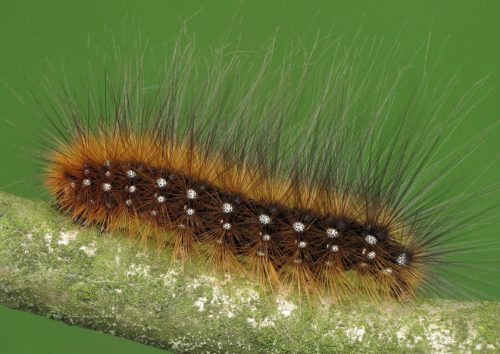
The garden tiger moth caterpillar is also called woolly bear due to the defense coat of hairs all over its body. The chestnut brown hairs on the sides and white along the back are the distinctive features.
The barbed hairs can irritate the skin when picking these crawling creatures without wearing protective gloves. These caterpillars are also poisonous to birds and other potential predators.
These woolly bear caterpillars turn into beautiful moths with black, white, and orange markings on their wings. Garden tiger moth caterpillars feed on plantains, docks, and dead nettles. They are often seen in the month of August in the UK.
Scientific Name |
Arctia caja |
Host Plants |
Dandelions, blackberries, clovers, and cherries. |
Identification Features |
Black and orange hairy body with long grayish spines sticking out. |
Walnut Caterpillar
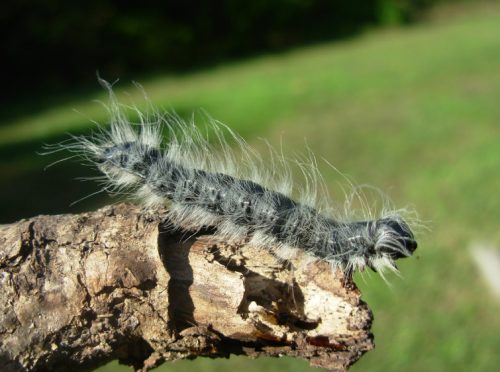
It is a hairy black caterpillar with long whitish-gray wispy spines to give it a fuzzy appearance. The black fuzzy caterpillar is harmless to humans though the spines can cause skin irritation and itchy rashes.
These crawling creatures have cylindrical and slender bodies that grow up to 30mm long. These black bugs feed in large groups by defoliating pecan, butternut, hickory, and walnut trees.
Scientific Name |
Datana integerrima |
Host Plants |
Walnut, butternut, pecans, and hickory trees. |
Identification Features |
Slender caterpillar with a black body covered in thin hairs. |
Monkey Slug Caterpillar
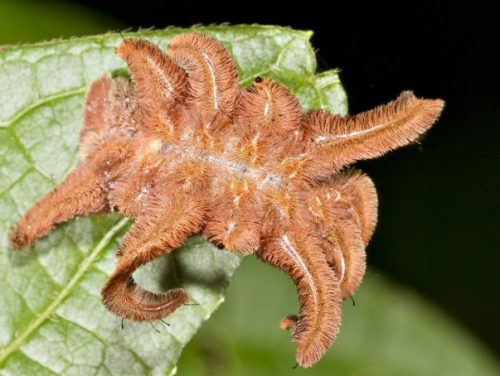
It is a strange-looking hairy caterpillar also called a hag moth caterpillar. The golden brown furry caterpillar has 18 curled hairy projections around its body giving the squashed spider appearance.
The monkey-slug caterpillars can grow up 25mm long with dark tan hairs covering their bodies. These hair tufts can cause severe skin irritation and other allergic reactions in human beings.
Scientific Name |
Phobetron pithecium |
Host Plants |
Apple, ashes, birches, chestnuts. Dogwoods, oaks, hickories, and willows. |
Identification Features |
Shaggy brown caterpillar with nine pairs of curly brush-like protrusions. |
Salt Marsh Moth Caterpillar
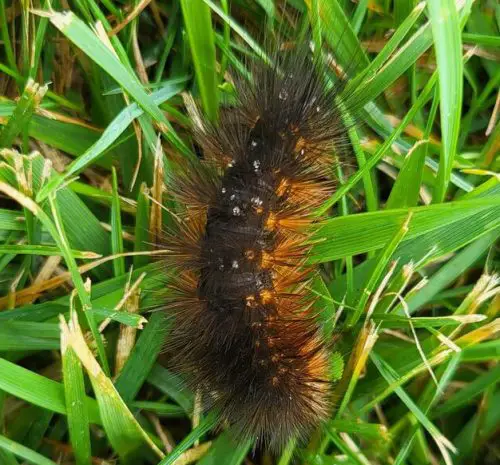
It is a brown hairy caterpillar with sharp-looking spines sticking out from its body. The sharp bristles are soft and cannot sting.
But the irritating hairs can make your skin feel itchy after handling or touching. The nine rows of orange warts with a white dot are the prominent features.
These brown furry caterpillars feed on peas, apple trees, cabbages, cotton, soy, and tomato plants. Use chemical treatments to eliminate these insects from your crops.
Scientific Name |
Estigmene acrea |
Host Plants |
Apple trees, cabbages, clovers, corn, cotton, peas, and tobacco |
Identification Features |
Slender caterpillar with a dark brown hairy body and a row of black or orange spots along its back. |
Hickory Tiger Moth Caterpillar
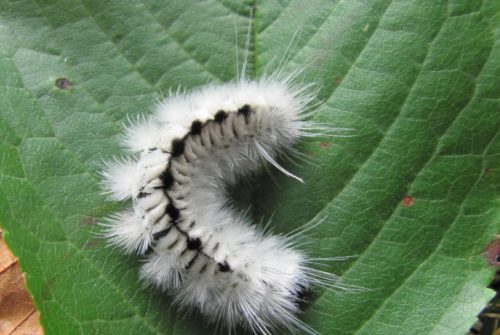
It is also called the hickory tussock moth caterpillar. The furry white caterpillar has diamond-shaped black patterns along its back.
The black pencil hair tufts and rounded shiny body are the distinctive features for easy identification. These black and white hairy caterpillars can grow up to 45mm long.
The barbed spines can cause mild or severe skin irritation. These furry white crawling bugs feed on pecan, walnut, hickory, and willow trees.
Scientific Name |
Lophocampa caryae |
Host Plants |
Birches, quacking aspen, basswood, and black locust. |
Identification Features |
White caterpillar with white hair tufts and black markings. |
Yellow Spotted Tussock Moth Caterpillar
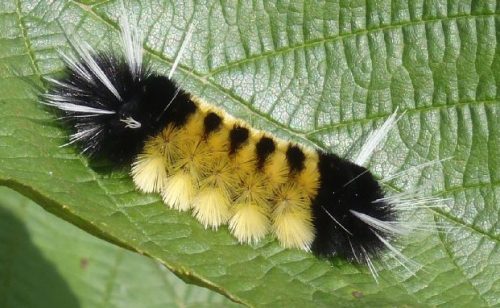
It is a black and yellow caterpillar with jet-black ends and long tufts of white hair pencils as distinctive features. Caterpillars are often seen on trees and shrubs.
The tussock moth caterpillar is also called the yellow woolly bear due to the moth’s furry appearance. The crawling creature can grow up to 30mm long.
Scientific Name |
Lophocampa maculata |
Host Plants |
Birch, maple, oak, poplar, and willow |
Identification Features |
Black and yellow caterpillar with tufts of white lashes on its head and rear end. |
Fall Webworm
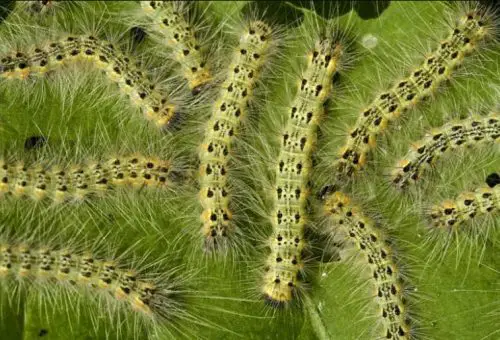
It is a hairy white or pale-yellow caterpillar covered in thin whitish spines. These crawling insects create tent-like structures beneath the leaves for protection.
The rounded shiny black or redhead is the other identification of the fall webworm caterpillar. These larvae spend most of the time in the tent daggling on tree ends.
These fuzzy white caterpillars grow up to 35mm long and turn into spectacular white moths after pupation. These slender hairy bugs feed on the leaves of trees and shrubs.
Scientific Name |
Hyphantria cunea |
Host Plants |
American elm, birch, hickory, and some maples. |
Identification Features |
Slender black or dark brown with thread-like hairs covering its body |
Pale Tussock Moth Caterpillar
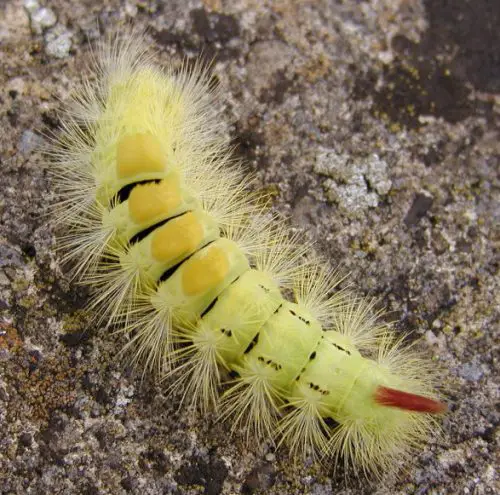
It is a unique hairy caterpillar with yellowish-green color and fuzzy appearance. The tufts of hair along its back are the distinctive features.
The conspicuous reddish tufts of lashes at the rear end are among the few identification features of pale tussock moth larvae. The black stripes are visible when it curls.
The furry caterpillar can grow up to 40-45mm long and keeps changing color at each growth stage. The colors range from red, pale brown, and green.
Scientific Name |
Calliteara pudibunda |
Host Plants |
Blackthorns, hawthorns, oaks, hazel, crab apple, and birches |
Identification Features |
Toothbrush tufts of bright yellow spines and long pencil hairs at the rear end. |
Fox Moth Caterpillar
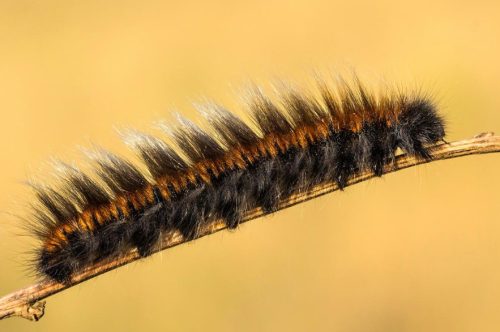
It is a black hairy caterpillar with a bright orange back and black hair tufts covering its body. The furry black and orange caterpillar turns into a beautiful tan-colored furry moth.
These furry caterpillars love feeding on small shrubs flowering perennials, and backyard or wild trees. The common trees are birches, willows, oaks, and other low-growing plants in the bean family.
Scientific Name |
Macrothylacia rubi |
Host Plants |
Heathers, bramble, sallows, bilberry, salad burnet, and meadowsweet. |
Identification Features |
Hairy black body with bright orange markings along its back. |
Virginia Ctenucha
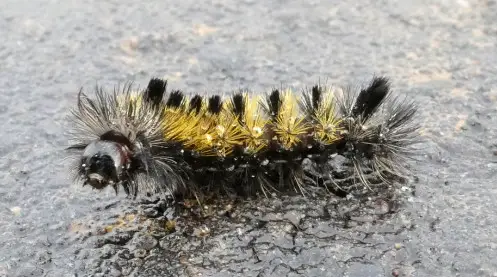
It is a furry caterpillar with white and yellow tufts giving it a fuzzy appearance. The creamy white hairy caterpillar has a redhead and crimson red prolegs.
The crawling insect loves hiding beneath the green foliage making it difficult to spot. It can grow up to 20-25mm long and turns into the largest wasp moth.
The black hairy caterpillar has white stripes along the sides for easy identification and classification. The slender bodies with colorful hairs are the distinctive features.
Scientific Name |
Ctenucha virginica |
Host Plants |
Grasses, sedges, and irises. |
Identification Features |
White and yellow tufts of hair cover its slender body. |
Miller Moth Caterpillar
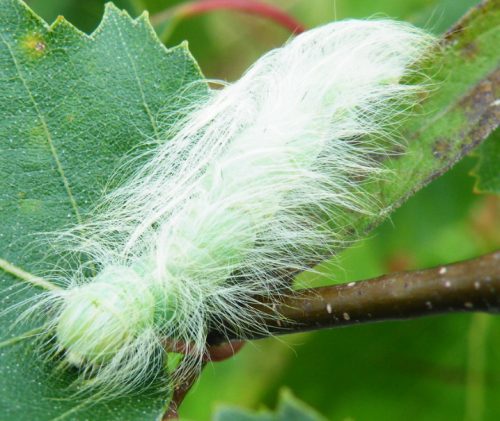
It is a hairy white caterpillar with a green body. A mature miller moth caterpillar has silvery-white hairs that turn yellow when approaching the pupation phase.
The furry caterpillar grows up to 35mm long, and they are often seen from July to October. They are found in woodland and heathland in the south of England.
Scientific Name |
Acronicta leporina |
Host Plants |
Poplar, alder, and birch trees |
Identification Features |
Green body with silvery white hairs |
People Who Read This Also Read:






